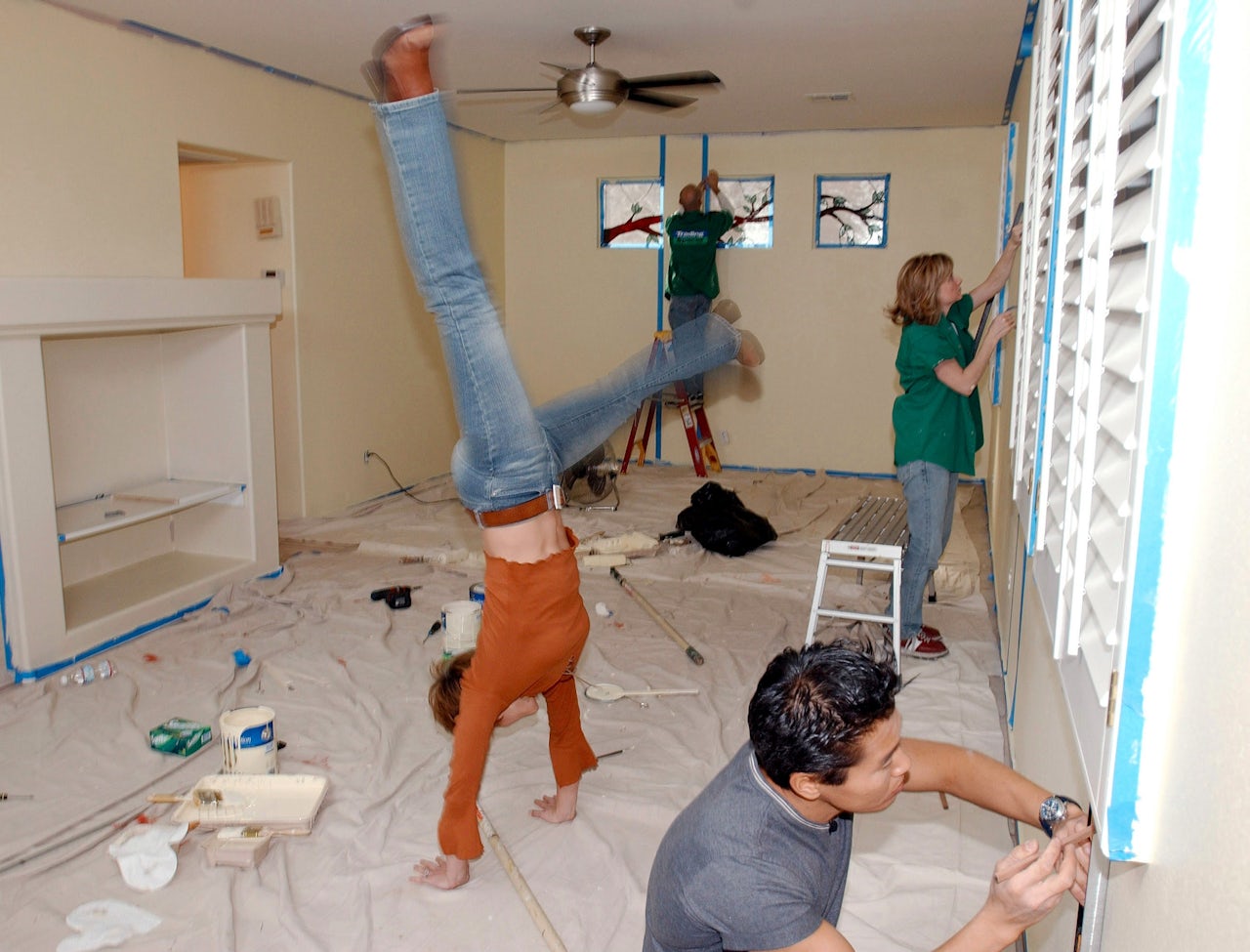Chris and Casey couldn’t agree on the partitions, the sunburst, or the color of their newly decorated bedroom. The couple, contestants on an early episode of Trading Spaces, had different reactions to the drab beige-and-brown renovation of the room, which was only slightly less drab than its original beige-and-blue decor. In a delightfully awkward scene, Chris praises the makeover: “Oh my gosh, that is really cool.” His partner, however, hates it with every fiber of her being: “That? No,” she says. “No. No. I don’t like it.” To the friend responsible for the upgrade, she adds, clutching a glass of wine, “I’m sure you do [like the partitions]. Now do you want to help me take them down?” The goofy, minor conflict epitomizes the inelegant interactions that made the show a hit for TLC in the 2000s.
After a decade off the air, Trading Spaces is returning to television, the network recently announced. Come 2018, viewers will be able to tune in to satisfy their appetites for home improvement knowledge, renovation ideas, and a ton of drama. (In an era filled with remakes and reboots of classic films — Beauty and the Beast and The Matrix are just two recent examples — Discovery Communications, which owns TLC, is also bringing back the shows Cash Cab and Mythbusters.) Trading Spaces, whose original run lasted from 2000 to 2008, was based on the format of the BBC TV series Changing Rooms. Like any successful reality show, its premise is straightforward: A pair of neighbors is tasked with redecorating a room in each other's home, on a budget of $1,000 (later upped to $2,000 and to $50,000 on one special episode) and with the help of an interior designer.
And people loved it: The show was nominated for multiple Emmys and, at its peak in 2003, it was bringing in 4.6 million viewers per new episode, according to The New York Times. By 2006, viewership had dropped to 800,000 per new episode, reflecting a decline across the board at TLC. But the show had preempted an entire phenomenon. Shows like Extreme Makeover: Home Edition, in which “deserving families” are gifted with new, professionally designed homes, found primetime success. Home design shows of all formats filled up airtime across cable. And in spite of economic upheaval and an uncertain housing market, the genre remains beloved for the same reasons it was popular in the first place: a convenient combination of aspirational themes and a culture of voyeurism.
While I was growing up, my mother religiously watched cooking and home improvement shows. The former made immediate social sense to me; she was a mom who cooked and provided, so it stood to reason that she would watch shows about cooking and providing. But, for the longest time, I failed to understand the appeal of programs like PBS’s Hometime and HGTV’s Design on a Dime, in which people often argued over money while trying to find practical solutions for their domestic dilemmas. Whether it was a decision about the right shade of turquoise for a bathroom tile or a debate over the authenticity of a polished granite countertop, 12-year-old me failed to see what the big deal was.
But years later, when I lived by myself and had to work with a budget of my own, home design shows began to feel relevant. I didn't own an entire home to decorate or renovate, but I did have a room that I rented and that room was a continuation of who I was, what I believed in, and what I liked and disliked. I lived vicariously through contestants who sought to improve their lives with better paint choices and better reading nooks. Like them, my living space should feel like an extension of my identity, I thought. Suddenly, shows like Trading Spaces made sense: When contestants completely despised the renovations their homes received, I could actively sympathize with their reactions. Will Melinda ever find the perfect bamboo blinds to correctly convey her personality to the world? Stay tuned to find what happens at the end of this philosophical quagmire in modern-day individualism.
Makeovers carry immense cultural power because they suggest that enhancing one’s body, house, or car leads to a better, brighter future.
Home improvement shows capitalize on our era’s obsession with “authenticity” as a seductive marketing tool. It’s a sexy word whose underlying promise to consumers is that any given product, upon consumption, can be a springboard to happiness. Your most authentic self is your best self, billboards and commercials scream. And if you haven’t actualized that self, a radical intervention in the form of a makeover can help. Makeovers, of people or their homes, have long permeated popular culture as tropes in film and on television: Consider the thrust of the teen classic She’s All That, for example, or the dozens of Oprah Winfrey Show episodes that feature a similar premise, or the hilarious MTV show Pimp My Ride. Makeovers carry immense cultural power because they suggest that enhancing one's body, house, or car leads to a better, brighter future. More success, more happiness, more upward mobility.
Even more enthralling than the fact of the transformations is watching people in the privacy of their homes, as they make personal decisions we otherwise wouldn’t be privy to. This is where shows like Trading Spaces tap into our innate and undeniable propensity for voyeurism while using cable TV to satiate our greed. Television, as David Foster Wallace wrote in a 1993 essay, is a deus ex machina for voyeurs where we not only feed off of other people’s narratives but, perhaps more importantly, project our own aspirations onto them. And since many of our longings are rooted in economics, the capitalist twist makes sense. Home decoration shows exist against a background where property values fluctuate and economic distress is a constant. More than anything else, home design shows flirt with the American dream and its promise that if you work hard enough, you can be happy.
It’s worth noting that Trading Spaces is making its comeback at an interesting moment. As Americans become more and more disillusioned with our national identity — and with key components like a living wage and retirement security increasingly unachievable — the show has a difficult promise to sell, to an audience whose members may have become hardened in recent years. But desire is tough to tame, even when our material conditions cannot afford fulfilling it. With a hero (or two, in the case of Trading Spaces), a conflict, a course of action, and a resolution, home renovation shows make us believe that happiness is attainable as long as you have the money — or the production crew of a reality TV show behind you.

